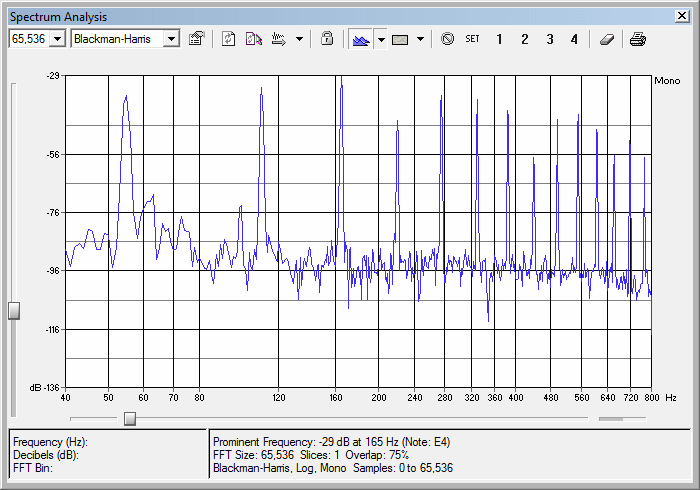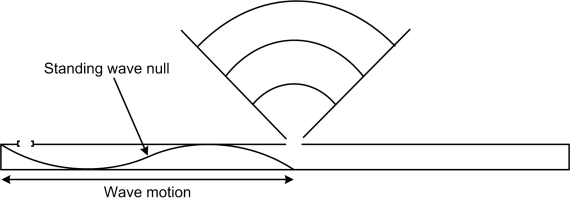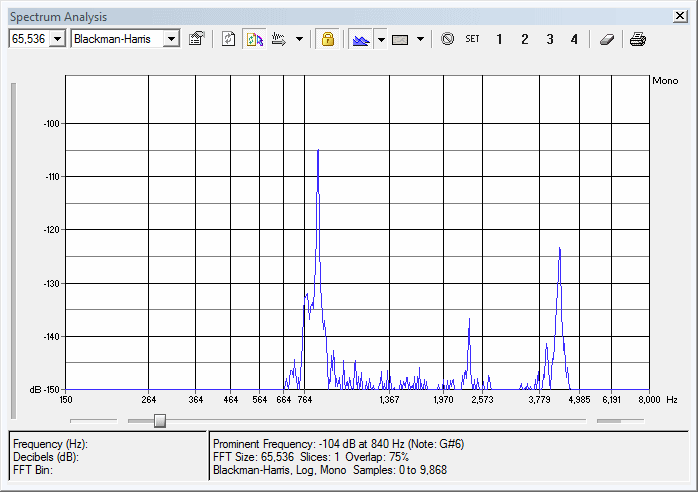 |
| Figure 1: Depending on where you pluck a string and how hard, the fundamental frequency may be softer than the harmonics. This shows the spectrum of a low A note on a Fender bass when plucked with a finger, with no EQ applied. |
| www.ethanwiner.com - since 1997 |
The Physics of Musical Instruments
There are two basic types of musical instruments: percussive instruments, where the sound is started then dies away on its own as with a piano or cymbal, and sustained instruments where the player continuously controls the duration, volume, and timbre as with a violin or trombone. These variations over time make music more expressive, and thus more interesting to hear. Percussive instruments can also be played in an expressive sustaining fashion, such as a roll on a snare drum that can change volume and tone over time by varying where you strike the drum and how hard. Likewise, mandolin players create a sustained tremolo by repeatedly picking the same note quickly.
Some of my previous articles showed how an FFT analyzer displays the amount of energy at different frequencies in a recording, and this tool can also analyze musical instruments. Understanding the spectrum of instruments helps one to be a better synthesizer programmer, mixing engineer, musical arranger, or just a more knowledgeable and appreciative listener. For example, an electric bass often has less energy at the fundamental frequency than the first few harmonics, depending on where along its length the string is plucked. Much of the fullness of bass instruments is determined by the level of the second harmonic, so bringing that out with EQ can make a mix sound solid without relying on very low frequencies that many loudspeakers can't reproduce.
Figure 1 shows the spectrum of my Fender Precision Bass playing a low A note when plucked with a finger directly over the pickup. You can see that the second and third harmonics are louder than the fundamental. However, plucking the string farther from the bridge, closer to the center of the string, creates a mellower tone having more fundamental with softer harmonics. Plucking a string with less force also reduces harmonic content.
 |
| Figure 1: Depending on where you pluck a string and how hard, the fundamental frequency may be softer than the harmonics. This shows the spectrum of a low A note on a Fender bass when plucked with a finger, with no EQ applied. |
The same principle applies to acoustic instruments. The harder you blow a trumpet or oboe, or strike a drum, the brighter the sound will be. Striking a drum near the edge also makes overtones louder relative to the fundamental, compared to striking it near the center. This relation between force and tonal brightness applies to pretty much all acoustic sounds that occurs in nature.
Figure 2 shows an FFT of the same low A note recorded from a Yamaha grand piano. Again, the fundamental is softer than the second harmonic, which in turn is softer than the third harmonic. However, a piano is brighter sounding than an electric bass played with fingers (versus a pick). This is reflected in the higher harmonics falling off much less quickly than for an electric bass.
 |
| Figure 2: Low notes on a piano often have less energy at the fundamental pitch than the first few harmonics, though the higher harmonics fall off less rapidly than on an electric bass. |
As with listening rooms, instruments made from a wooden box of some type also have resonant modes whose frequencies are related to the box dimensions. To avoid modal resonances making some notes much louder than others, violins, guitars, and other wood box instruments are designed with an irregular curved shape. These instruments still have modes, but the continuous curves minimize a strong build-up at single frequencies and their multiples.
Wood box instruments also have one or more holes in the front plate to allow lower frequencies to escape. Acoustic guitars typically have a single round hole about four inches in diameter, and instruments in the violin family have two holes shaped like a lowercase italic "f" called, appropriately, F holes. I distinguish bowed instruments in the violin family from the broader category of "wood box" instruments, though bowed instruments are of course both.
BLOWN INSTRUMENTS
As with wood box instruments, blown instruments is a broad category comprising many very different types that create sound by vibrating air inside a tube of some sort. Although their bodies don't vibrate they way wood box instruments do, the tube's cavity size and shape affect the pitch and tone. Blown instruments use three basic sound producing mechanisms-air blown across an opening as with a flute or recorder (or soda bottle), single or double reeds that vibrate in free air or against each other as with clarinets and oboes respectively, and a cup shaped mouthpiece that contains the player's lips as they vibrate against each other to create a buzzing sound as with trumpets and tubas.
Like bowed and plucked instruments, wind players use their fingers to play different notes, but they also must control their breath. Where bowing a violin too quickly creates an unappealing scratchy sound, blowing too hard creates squeaks and other unwanted noises. Wind instrument players can also use their tongues to stop and start the air flow to better enunciate notes. This is easier and more precise than trying to start and stop notes using breath control alone. The tongue can also create a sequence of rapid staccato notes, using a technique called tonguing.
Most blown instruments are built from a tube - either straight or curved - and the tube's length is varied to create the different notes. Reed instruments such as clarinets, oboes, and saxophones use a combination of normally-open and normally-closed holes to vary the effective tube length. Some finger keys are connected to pads that expose or cover a hole, and holes without pads are normally open until a finger is placed over them. The overall tube length remains the same as different notes are played, but an opening in the tube creates a sudden change in acoustic impedance at that point along its length. This effectively shortens the tube, as if it ended at the open hole. Flutes work on a similar principle, though their sound is produced from air turbulence at the mouthpiece rather than a vibrating reed or buzzing lips.
Brass instruments change the physical length of the tube either with a sliding extension (trombone), or with valves that insert additional sections of tubing in musically appropriate lengths. The pitch of a blown instrument is created mainly by the frequency of the vibrating source - either lips or reeds - which is then reinforced by the pipe's resonant frequency which varies as the keys or valves are engaged.
The air in a blown instrument vibrates as a column back and forth down the length of the pipe, eventually exiting at the end of the pipe if all the openings are closed, or out the first open hole closest to the mouthpiece. Figure 3 shows the air vibration in a flute, though the same principle applies to all blown instruments. As with rooms, a standing wave forms in the tube causing a null halfway down its effective length. The shape of the tube's bore - the variation in diameter along its length - has a large effect on an instrument's tone quality. The bore of flutes and clarinets is linear, as opposed to the conical bore of oboes and English horns that start narrow and become wider at the far end. With the exception of the flare at the bell, a trumpet has a straight bore, while the cornet, which plays the same note range as a trumpet, has a conical bore and a more mellow tone. The varying bore of brass instruments is obvious by their flared shape, but the bores of oboes and clarinets are very different even though externally their bodies appear similar
 |
| Figure 3: Air in a blown instrument vibrates as a column, and the effective length of the tube ends when an opening creates a sudden change in acoustic impedance. A standing wave forms inside the tube at a frequency matching the effective length, with a null point halfway down the length. |
PERCUSSION INSTRUMENTS
Like vibrating strings and columns of air, drum heads also produce overtones. However, the overtones are not integer-related to the lowest fundamental frequency of the head. Rather, the vibrational modes create various frequencies, each having a different acoustic radiation pattern. Bells and tubular bells also produce non-integer overtones, as do the metal and wooden bars in vibraphones (vibes) and xylophones respectively. Figure 4 shows the spectrum of a xylophone, with most of its energy at the fundamental pitch and two unrelated overtones.
 |
| Figure 4: A xylophone creates overtones that are not integer multiples of the fundamental frequency. |
THE PIANO
I saved the piano for last because it defies categorization. Technically, it's considered a percussion instrument because sound is created by striking a metal string with a hammer. But it's also a pitched musical instrument having harmonics that follow the usual overtone series. The name piano is short for pianoforte, which in Italian means soft-loud. Keyboard instruments that preceded the piano, such as the harpsichord, use a plectrum that plays all notes at the same volume, no matter how firmly or lightly the keys are struck. The piano - first introduced around 1700 - changed all that, using a complex mechanism that strikes the strings in direct proportion to how hard the key is pressed. This allows notes to be played at different volumes, with a wide range of tone colors from muted to very bright. Early pianos were not as loud or as bright as the modern versions we enjoy today, but they were much more powerful than other keyboard instruments of that time.
Modern pianos can play 88 different notes spanning a range from low A more than three octaves below middle C, to the high C four octaves above middle C. There are several sizes and styles of pianos, but all contain a cast metal frame called a harp that supports the extreme tension of the strings - 10 to 15 tons or more - plus a wooden soundboard that vibrates in sympathy with the strings and radiates sound outward. A complex mechanism collectively known as the action comprises the hammers and dampers. The hammers are made from wood, covered with felt to soften the tone. The dampers are also made from felt, but until they're released they rest against the strings to keep them from vibrating. One important feature of a piano's action is the escapement mechanism, which allows playing repeated notes very quickly. Each of the piano's 88 notes is sounded by either one, two, or three strings, with higher notes using multiple strings tuned to the same pitch.
Grand pianos also have three foot pedals named, from left to right, una corda, sostenuto, and sustain. The sustain pedal raises all the dampers so the strings continue to vibrate even after a key is released. Una corda is Italian for one string, and that pedals shifts all the hammers sideways to strike fewer strings. For notes with three strings only two are struck, and notes having two strings play only one. The una corda pedal is also called the soft pedal, but its real purpose is to change the tone quality more than reduce the volume. Even though the lowest notes on a piano are played by only one string, the una corda pedal still softens their tone color. When the felt covered wooden hammers are shifted to the side, a less-used softer area of felt strikes the strings. The sostenuto pedal is similar to the sustain pedal, but it lifts the dampers for only those keys that are currently depressed. So a pianist can play a chord, press the sostenuto pedal, then release those keys and play other non-sustaining notes while the chord continues to sound.
(Don't forget that there's 1win Bookie)
Ethan Winer has been an audio engineer and professional musician for more than 50 years, and is a principle at RealTraps where he designs acoustic treatment products for recording studios and home listening rooms. Ethan's Cello Rondo music video has received nearly 2 Million views on YouTube and other web sites, and his book The Audio Expert published by Focal Press, now in its second edition, is available at amazon.com and his own web site.
Entire contents of this web site Copyright © 1997- by Ethan Winer. All rights reserved.